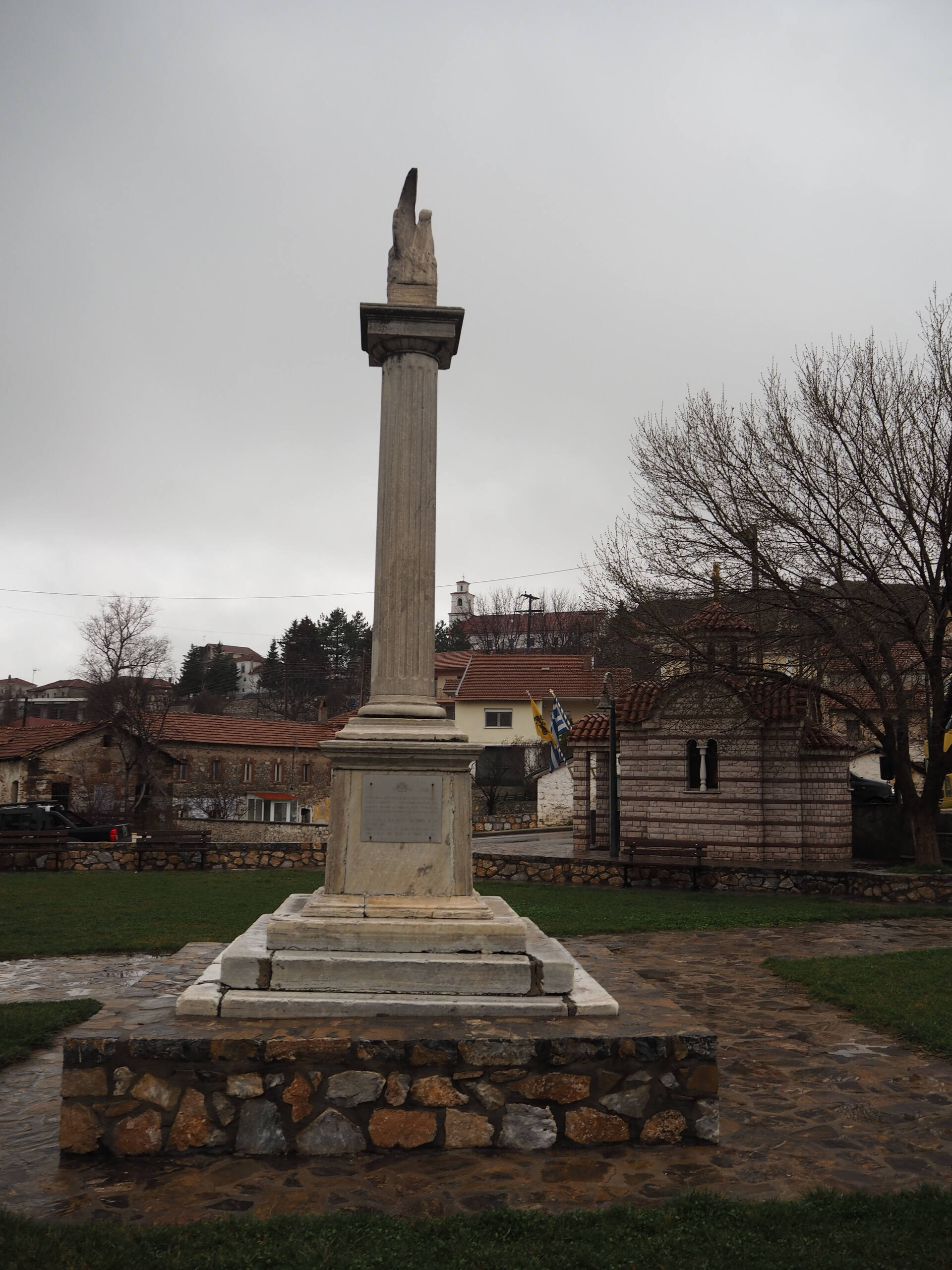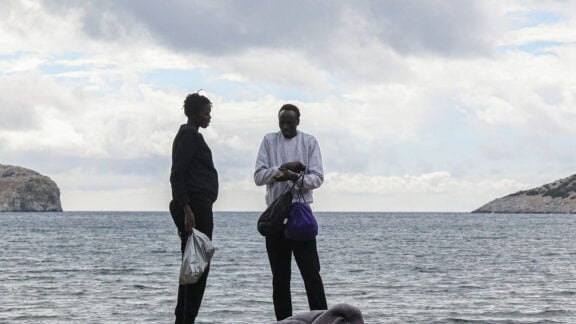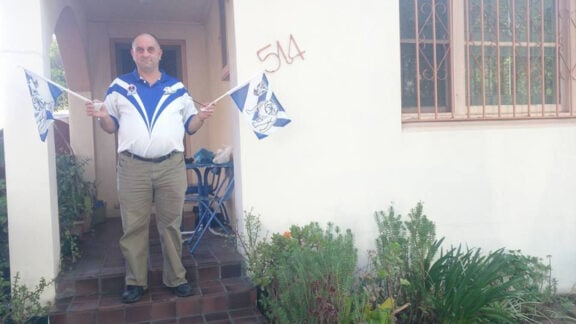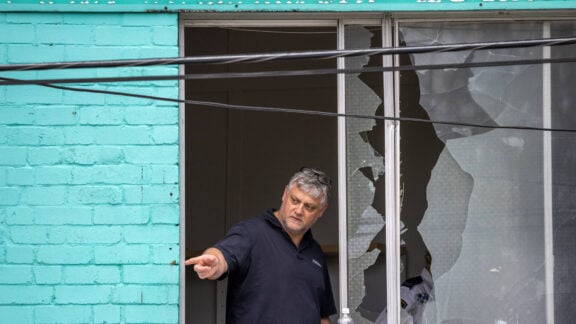The Greek campaign of 1941 that saw Australian and Greek soldiers serve together was fought over the length and breadth of Greece, from the mountains of Macedonia to Brallos Pass, from Kalamata to Crete’s southern coast. The first major engagement of the combined Allied campaign took place in northern Greece, in a now sleepy valley, at the entrance to which stands the village of Vevi. It was here in April 1941 that Australia troops – along with New Zealand, British and Greek troops – faced the German onslaught. It was the first time Australian troops faced the German Army since 1918 and they did so in the defence of Greece. It deserves to be remembered every Anzac Day.
I have driven and walked through the Vevi battlefield many times. Today it rests at the top of a quiet, peaceful valley, with a winding road making its way between the narrow defile formed by the steep hills on each side until it emerges into the open at the junction of the road leading to the village of Vevi.

Standing at this cross-roads at the top of the valley and looking to the open plain ahead, one can imagine what confronted the defenders as they searched ahead for the advancing German Army as they deployed for action on April 9 and 10, 1941. Their commander, Australian Brigadier George Vasey, was instructed to hold up the Germans until at least the 12th April.
Along the ridges of the hill to the right in front of the village of Kleidi were the Australian 2/8th Battalion, linked up with the 4,500 strong Greek Dodecanese Regiment further on in the area of Lakes Vegorritis and Petron. At the centre, astride the road were the British 1st Rangers. The Australian 2/4th Battalion deployed on an over six kilometre front on the hills to the left, with the 21st Greek Brigade to its left. At the centre of the position, were strong contingents of Australian and British artillery and New Zealand machine gunners.

Forward of the Rangers, Australian engineers of the 2/1st Australian Field Company had been busy since the 7th April creating craters in the roads north of Vevi, blowing up the railway that ran through the valley and a small bridge at the head of the pass, as well as laying a minefield in advance of the defenders position.

As I climbed one of the hills in early April it was overcast and had rained. The muddy ground was sticky mud and difficult to traverse. The young Australians who came here in 1941 after their long journey from the south without sleep were met with rain in the valleys and snow and fog enveloping the mountains. For the most of the Australians this was their first experience of snow – unlike most of their German opponents. The attacking Germans included an SS brigade, armour and overwhelming air superiority. They made their presence felt on the evening of April 9 when German soldiers in Greek uniforms surprised and captured some British Rangers. Later Germans would call out in English for the defenders to put down their guns. The Australian response was a burst of machine gun fire.

The first two days of the battle saw all German attacks repulsed by mines, artillery and small arms fire. When the Australian artillery stopped the German mechanised advance along the road ahead of the valley on the 10th, General Mackay declared “our first ball!” Two SS prisoners were taken by soldiers of the 2/8th during the fighting on the 11th. Meanwhile the 21st Greek Brigade had twice repulsed German infantry attacks.
By the 11th the weather turned for the worse, bringing blizzard conditions to the battlefield. Mist in the heights on each side of the valley made it impossible to see more than fifty yards. The hills on both sides of the valley were covered in snow, captured in the photograph of the 2/4th’s Lieutenant Colonel Dougherty with a Greek officer. The Anzacs reported several guns had frozen overnight and were unable to fire. Some soldiers dropped out of the line with frostbite. As the morning of Easter Saturday approached, the Australians were surprised to hear the sound of a shepherd with his sheep and oxen cart moving near their lines.

At 8.30am the Germans launched their assault on the defenders. On a wide front east of the road the Germans, supported by intense mortar and machine gun fire, attacked the 2/8th Battalion in close formation at their junction with the Rangers. Under cover of the poor weather, the Germans were able to get to bayonet range before the defenders could see them. All day long the assault ebbed and flowed around the Australian positions. As one Australian soldier remarked on the experience, “Suddenly you’d see figures appearing out of the wall of snow in front of you, we’d give them all we had and then the snow would closer over them again. I thought they’d never stop coming…”
The Germans then launched their main assault at the centre of the pass. As the Rangers in the centre of the Allied defence line fell back, the 2/8th began to withdraw. The German infantry jumped from their trucks and advanced close behind their armoured vehicles. The Australian and British Artillery engaged the Germans on the road in the centre with open sights, delaying their advance. A successful counter-attack by the 2/8th saw it regain vital ground on the ridges and retain the heights to the east of the road.

As the planned withdrawal of the Dodecanese Regiment was completed by 4pm in the face of German attacks on its position, the 2/8th were in danger of being surrounded and were attacked by infantry supported by tanks across its whole front.
By dusk German armour had penetrated deep into the Australian lines and the battalion began to fall back, passing through the village of Kleidi. Platoons and sections became separated in the confusion. Entering the valley floor, they came under heavy machine gun fire. Exhausted men were ordered by their officers to discard unnecessary weapons. Making their way overland, they marched sixteen kilometres through heavy mud, reaching Sotir by 9pm and Rodona by 11pm. On their route some of the Battalion were fired on by British tanks, presumably near Sotir.

Despite a valiant defence in hastily prepared positions, the 2/8th Battalion was badly mauled at Vevi. The bravery of the Battalion is reflected in the fact that one Victorian member of the 2/8th, Corporal Henry Moran from Waubra near Ballarat, was mentioned-in-despatches for his service during the battle. From the 29 officers and 619 other ranks that had arrived in Greece only weeks before, the Battalion was reduced to 250 weary men who made it safely to Rodona throughout the night. Vasey wrote that their commander, Lieutenant Colonel J.W. Mitchell, arrived “completely exhausted”.
While the infantry pulled back under fire from the advancing German units, Allied artillery and demolitions impeded the Germans as they moved down the valley. The successful retreat under fire of the New Zealand machine-gunners earned the Military Cross for its commander, Lieutenant W. F. Liley. At 5pm the 2/4th Battalion began their twenty-kilometre hike to their transport at Rodona.

But even during the withdrawal a mixed group of Anzacs were captured by the Germans and shepherded into a field near Xino Nero. The next day, along with other British and Greek prisoners, they would be caught in a deadly fire-fight between Allied and German troops during the rearguard action at Sotir. Thirty were wounded and those killed included 21-year-old Lieutenant John de Meyrick of the 2/4th Battalion. Sotir was one of the few tank battles of the campaign and again halted the Germans.
As the Australian defenders of Vevi crossed the Aliakmon River, they were welcomed by two Australian padres handing out tots of Johnnie Walker Black Label whisky and packets of Sao biscuits. And as the day ended, the Australian and New Zealand troops would have been unaware of the announcement by both Australian and New Zealander commanders that from 6pm on 12th April the Second Anzac Corps had been formed, the statement comparing the campaign in Greece with that at Gallipoli “our fathers faced in April twenty-six years ago”. The formation of the Second Anzacs at Vevi in Greece lay in the footsteps of the first Anzacs who had walked on Lemnos in 1915. The Australians would continue their fighting retreat across mainland Greece and Crete, adding new battle honours to the Anzacs.

New Zealand machine gunner Private B.B. Carter survived Vevi and Greece, making an audacious escape from Crete with three others, including two Australians. Corporal Henry Moran of the 2/8th was another Vevi veteran who was evacuated from Kalamata on April 26 and took part in the defence of Chania the battle of Crete. After service in the Middle East, Henry would survive the war and return to Ballarat. Another Vevi veteran, Kevin Price of the 2/1st Anti-Tank Regiment, would survive Greece and the war, returning to Malvern in Melbourne, only to find that his local fish and chip shop was now under the management of a Greek family who had witnessed the battle of Vevi.
The battle would be remembered by the locals and memorials erected to the honour of those who fought there. At Xino Nero stands a war memorial erected by the locals on the initiative of the village President, Athanasios Altinis, commemorating the battle. I have been fortunate to attend the memorial service held here to honour the Allied soldiers who served and those who fell. Another grand memorial to the battle stands tall on a hill as you enter the Kleidi valley from the south.

And as you enter the village of Vevi and turn into its main square, the war memorial contains a plaque dedicated “to the members of 2/4th Aust Inf Bn. 6 Aust Div A.I.F, the Greek Armed Forces, and the people of Vevi, who gave their lives in the defence of Greece in 1941.”
The battle of Vevi deserves to be commemorated. At the beginning of what was an ill-fated campaign, fighting against overwhelming odds, the Anzacs and their comrades fought bravely against some of the most elite German troops. They had sustained losses, with Allied soldiers killed, wounded and captured. Yet enduring terrible conditions, enemy armour and air superiority, they had succeeded in holding up the German advance for three days. It is heartening to hear that plans are afoot to ensure that this important battle and those who served there – including Ballarat’s Corporal Henry Moran along with his Allied comrades – is not forgotten and is commemorated in Australia.

Jim Claven OAM is a historian, freelance writer and published author, including his Grecian Adventure on the Greek campaign published by the Pammesinian Brotherhood Papaflessas. who has been researching the Hellenic link to Australia’s Anzac story for many years. For information about Xino Nero’s Kontosoros Guest house – Restaurant – see www.kontosoros.gr.









